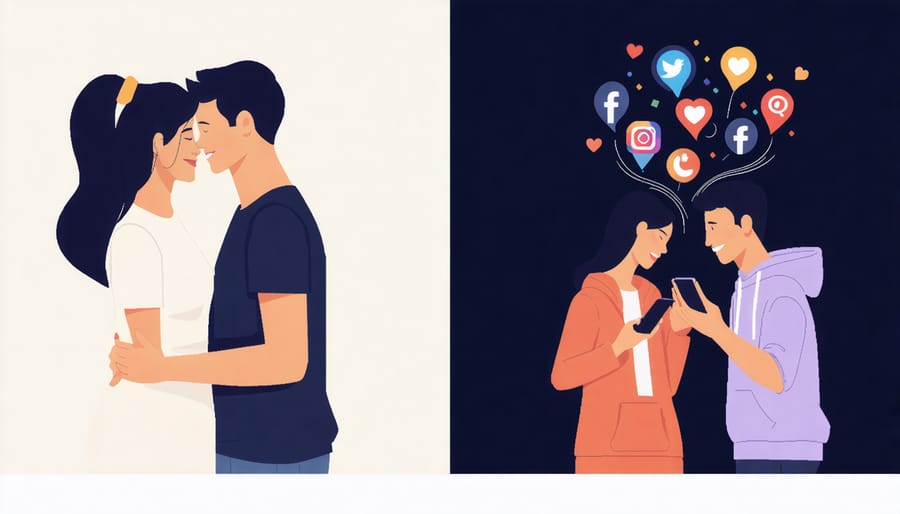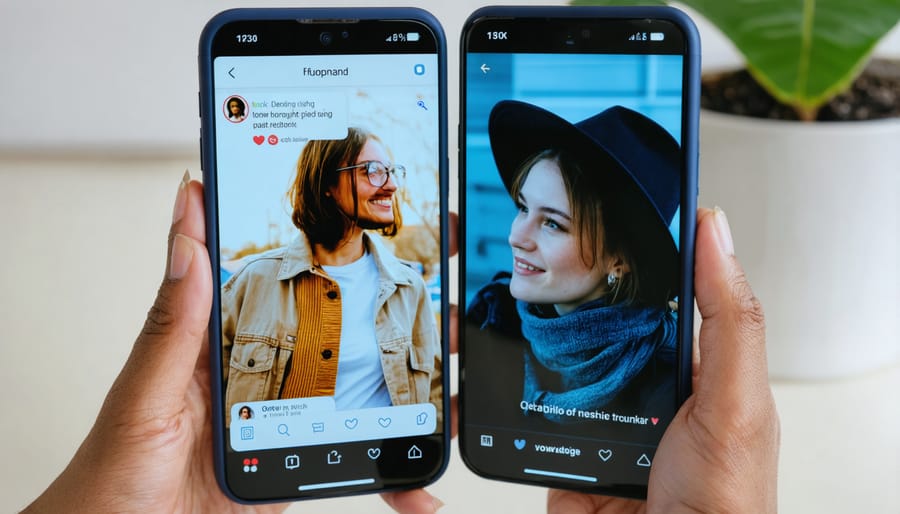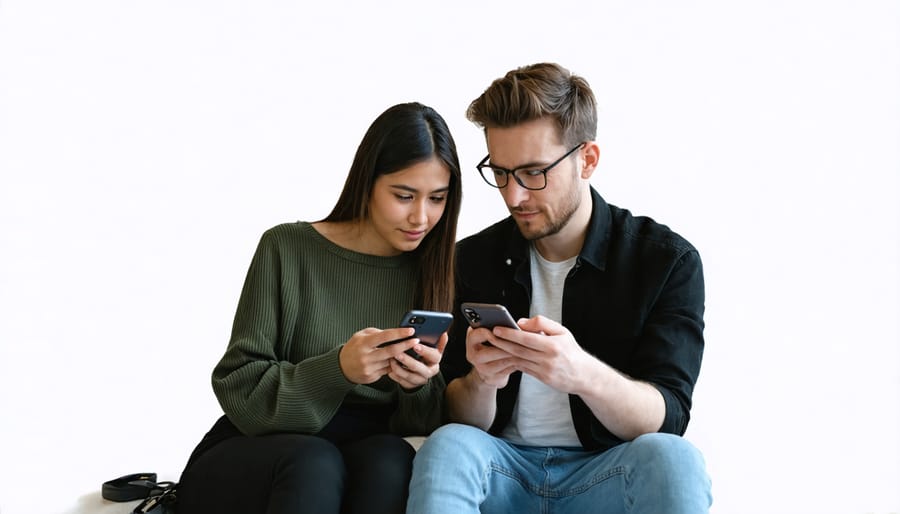
In an age where likes and comments shape our daily interactions, social media has fundamentally transformed how we build, maintain, and sometimes destroy our closest relationships. Recent studies show that 60% of couples report social media negatively impacting their relationship trust – yet paradoxically, these same platforms offer unprecedented opportunities for real connection through virtual communication.
Picture this: You’re enjoying a quiet dinner with your partner when both your phones light up with notifications. That familiar urge to check them creates an invisible barrier between you – a scene playing out in millions of homes every evening. While social media promises to keep us connected, it often leaves us feeling more distant from the people sitting right beside us.
The impact isn’t just anecdotal. Research reveals that excessive social media use correlates with increased relationship dissatisfaction, jealousy, and trust issues. However, understanding these dynamics empowers us to make conscious choices about how we integrate digital connection into our relationships without letting it overshadow genuine human connection.
Whether you’re navigating a new relationship or strengthening a long-term partnership, recognizing social media’s influence on your relationship is the first step toward creating healthier digital boundaries while maintaining meaningful connections in our increasingly online world.
How Social Media Changes Our Trust Dynamics
The Digital Window Effect
Remember when relationships meant peeking through actual windows? Now, our smartphones have become virtual windows into our partner’s lives, offering unprecedented access to their digital footprint. Just the other day, a friend confessed how she found herself scrolling through her partner’s Instagram likes at 2 AM – a scenario many of us can relate to.
This constant digital visibility creates what I like to call the “always-on relationship spotlight.” Every like, comment, and share becomes visible, potentially triggering questions and insecurities that might never have surfaced in the pre-social media era. While this transparency can foster closeness, it often leads to overthinking and misinterpretation.
Think about it: seeing your partner interact online with an ex or watching them engage with posts you might find questionable can plant seeds of doubt, even in the most secure relationships. The challenge lies in distinguishing between genuine red flags and harmless digital interactions.
However, this window effect isn’t entirely negative. When approached mindfully, it can actually strengthen relationships. Many couples use this visibility to better understand each other’s interests, share moments throughout the day, and stay connected in meaningful ways. The key is finding the right balance between staying informed and respecting each other’s digital privacy.
Remember, just because we can look through this digital window doesn’t always mean we should. Sometimes, closing the blinds and focusing on real-world connections proves more valuable for relationship health.

Virtual vs. Real-Life Personas
Have you ever noticed how different you might act on Instagram versus at a family dinner? We’re all guilty of it – carefully curating our online presence while being much more relaxed in real life. Just last week, I caught myself spending 20 minutes selecting the perfect filter for a coffee shop photo, while in reality, I was in my comfy sweats, hair messy, enjoying a casual morning with friends.
This disconnect between our virtual and real-life personas can create unexpected challenges in our relationships. When we present a highly polished version of ourselves online, we might inadvertently set unrealistic expectations for our partners, friends, and family. Think about it: how many times have you seen a couple’s perfect vacation photos, only to later hear about the arguments and travel mishaps they never shared?
The key is finding balance and authenticity across both worlds. Consider sharing more genuine moments alongside the highlights, letting your personality shine through consistently whether online or offline. This doesn’t mean oversharing every detail of your life, but rather being mindful of the gap between your digital and real-world self.
Remember, the strongest relationships are built on authenticity, not perfection. Your loved ones appreciate you for who you are, not for your carefully curated social media presence. By bridging the gap between your virtual and real-life personas, you create space for more meaningful connections and deeper understanding.
Common Trust Challenges in the Social Media Age
Digital Privacy Boundaries
In today’s hyper-connected world, finding the right balance between staying connected and maintaining personal space can feel like walking a tightrope. While social media keeps us linked to our loved ones, it’s essential to establish clear digital boundaries that protect both our relationships and our peace of mind.
Think of digital boundaries as the virtual equivalent of closing your front door – they’re not about shutting people out, but about creating healthy spaces for your relationship to thrive. Start by having an open conversation with your partner about your comfort levels regarding social media sharing. What details of your relationship are okay to post? Which moments should remain private?
One effective approach is implementing “phone-free zones” or dedicated times when both partners agree to disconnect and focus solely on each other. This might mean no phones during dinner, date nights, or the first hour after waking up. These small changes can make a significant difference in relationship quality and intimacy.
Consider practicing smart digital communication by being mindful of how and when you interact online. Instead of passive-aggressive likes or cryptic comments, prioritize clear, direct communication with your partner, whether online or offline.
Remember, it’s perfectly okay to maintain some digital privacy, even from your partner. Having separate social media accounts, personal passwords, and private conversations with friends doesn’t indicate a lack of trust – it’s a healthy expression of individual identity within a relationship. The key is finding what works for both partners while maintaining mutual respect and understanding.
The Ex Factor Online
Let’s face it – navigating past relationships in the digital age feels like walking through a minefield of memories, especially when your ex’s life updates are just a scroll away. I recently spoke with Sarah, a reader who shared her struggle with constantly checking her ex’s Instagram stories, even months after their breakup. “It’s like I can’t help myself,” she admitted, “even though I know it’s not helping me move forward.”
The digital footprint of past relationships can be particularly challenging to manage. Those tagged photos from happier times, shared playlists, and mutual friends’ posts can trigger emotional setbacks when they unexpectedly pop up on your feed. But here’s the good news: you can take control of your digital space to protect your emotional well-being.
Consider implementing what I call the “digital detox triangle”: unfollow or mute your ex’s accounts, adjust your privacy settings, and archive or delete photos that might cause emotional triggers. Remember, choosing not to view your ex’s social media isn’t about being petty – it’s about creating healthy boundaries for yourself.
Many women in our community have found success with the “30-day social media cleanse” approach. This involves temporarily deactivating your accounts or using apps that block specific profiles, giving yourself time to heal without the constant digital reminders of your past relationship.
The key is to be gentle with yourself during this process. If you slip up and find yourself down the rabbit hole of your ex’s profile, don’t beat yourself up. Instead, use it as a reminder to refocus on your own growth and the exciting new chapters ahead.

Building Stronger Trust in a Connected World
Setting Digital Boundaries Together
Just like setting boundaries in the offline world, establishing digital boundaries with your partner is crucial for maintaining a healthy relationship in today’s connected age. I remember when my partner and I first had to navigate this territory – it wasn’t always smooth sailing, but the conversations we had were invaluable.
Start by having an open, judgment-free discussion about your social media habits and concerns. Share your comfort levels regarding posting about your relationship, following ex-partners, or engaging with others’ content. Remember, there’s no one-size-fits-all approach – what works for one couple might not work for another.
Consider creating a mutual agreement about social media usage during quality time together. Maybe you both decide to put phones away during dinner or designate certain hours as “phone-free zones.” This isn’t about restricting each other; it’s about being present and maintaining genuine connection.
Be transparent about your social media boundaries. If something makes you uncomfortable, express it clearly but kindly. For instance, “I feel uncomfortable when you share private moments without asking me first” is more effective than accusatory statements.
Some practical boundaries you might consider:
– Agreeing on what aspects of your relationship to keep private
– Establishing guidelines for posting photos of each other
– Setting expectations about response times to messages
– Deciding how to handle friend requests from ex-partners
– Creating rules about phone usage during date nights
Remember that boundaries can evolve as your relationship grows. Regular check-ins about how these digital boundaries are working for both of you can help maintain harmony in your relationship while enjoying the benefits of social media.
Open Communication Practices
In today’s digital world, maintaining honest dialogue about our social media activities has become as crucial as building real emotional intimacy in our relationships. When we scroll through our feeds or engage with others online, it’s essential to keep our partners in the loop about our digital lives.
Start by establishing clear boundaries together. Have an open conversation about what makes each of you comfortable or uncomfortable regarding social media interactions. Maybe you’re okay with your partner maintaining friendships with exes online, or perhaps that’s a hard boundary for you. The key is discussing these preferences without judgment.
Create regular check-ins about your online activities. Share interesting posts you’ve seen, discuss new connections you’ve made, or talk about how certain social media interactions made you feel. This transparency helps prevent misunderstandings and builds trust. Remember, it’s not about monitoring each other – it’s about sharing your digital experiences as naturally as you’d share any other part of your day.
Be mindful of your partner’s feelings when posting about your relationship. Some prefer keeping things private, while others love sharing couple photos and relationship milestones. Find a middle ground that works for both of you, and always consult each other before posting something that involves both partners.
If something makes you uncomfortable – like a particular interaction or comment – bring it up gently and promptly. Don’t let digital concerns simmer until they become larger issues. By maintaining open dialogue about social media, you’re protecting your relationship while embracing the benefits of staying connected in our digital age.

Balancing Online and Offline Connection
In today’s hyper-connected world, finding the sweet spot between our online and offline relationships can feel like walking a tightrope. I remember when I caught myself scrolling through Instagram during a coffee date with my best friend – that was my wake-up call to reassess my digital habits.
The key to maintaining healthy relationships in the digital age lies in creating intentional boundaries. Try designating “phone-free zones” during meals or setting specific times for social media check-ins. This mindful approach helps ensure that your virtual connections don’t overshadow meaningful face-to-face interactions.
Consider implementing a “digital sunset” – a time each evening when you put away your devices to focus entirely on your loved ones. This practice has helped many of my readers strengthen their relationships while building a strong partnership with their significant others.
Remember, it’s not about choosing between online and offline connections – it’s about finding harmony between the two. Share photos of special moments on social media, but don’t let the pursuit of the perfect post distract you from experiencing the moment itself. Schedule regular offline activities with friends and family, like weekend hikes or monthly book clubs, to maintain those irreplaceable in-person bonds.
The goal is to use social media as a tool to enhance our relationships, not replace them. When we achieve this balance, we can enjoy the best of both worlds while nurturing the connections that truly matter.
As we’ve explored throughout this article, social media has fundamentally changed how we connect and communicate in our relationships. While these platforms offer incredible opportunities to stay connected with loved ones, they can also create unnecessary tension and misunderstandings if not managed thoughtfully.
Remember, it’s not about completely disconnecting from social media, but rather finding a healthy balance that works for both you and your partner. Start by having an open conversation about your social media boundaries and expectations. Maybe you’ll decide to have phone-free dinner dates, or perhaps you’ll make it a point to share exciting news with each other first before posting it online.
Consider implementing some of the practical tips we’ve discussed, like setting aside designated social media time, being mindful of what you share about your relationship, and focusing on real-world connections. Small changes, like putting your phone away during meaningful conversations or making eye contact instead of scrolling through feeds, can make a significant difference.
I’ve seen countless couples in my community transform their relationships by simply being more intentional about their social media use. Your relationship deserves your full attention and presence – something that’s harder to give when we’re constantly connected to our digital world.
Let’s commit to using social media as a tool to enhance our relationships rather than letting it create barriers between us and our loved ones.



